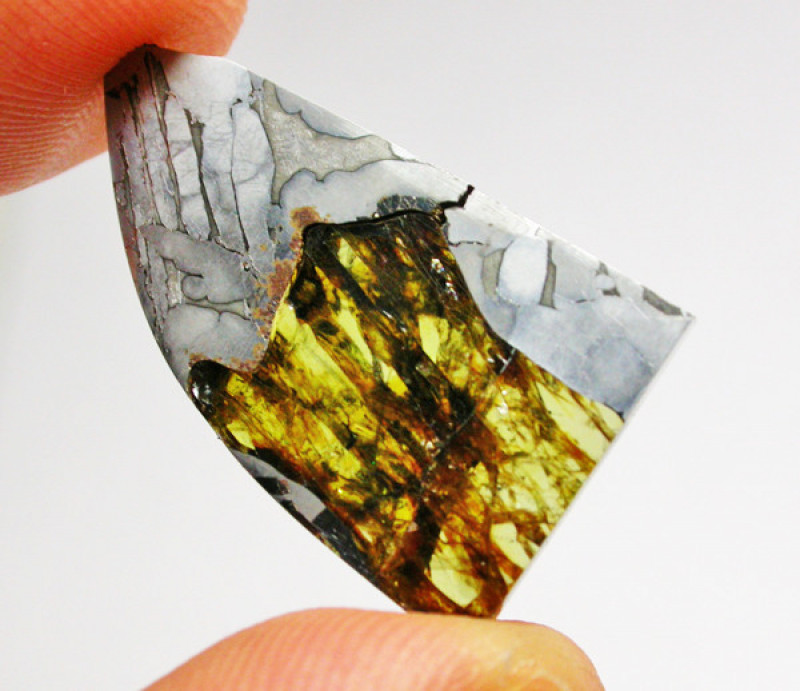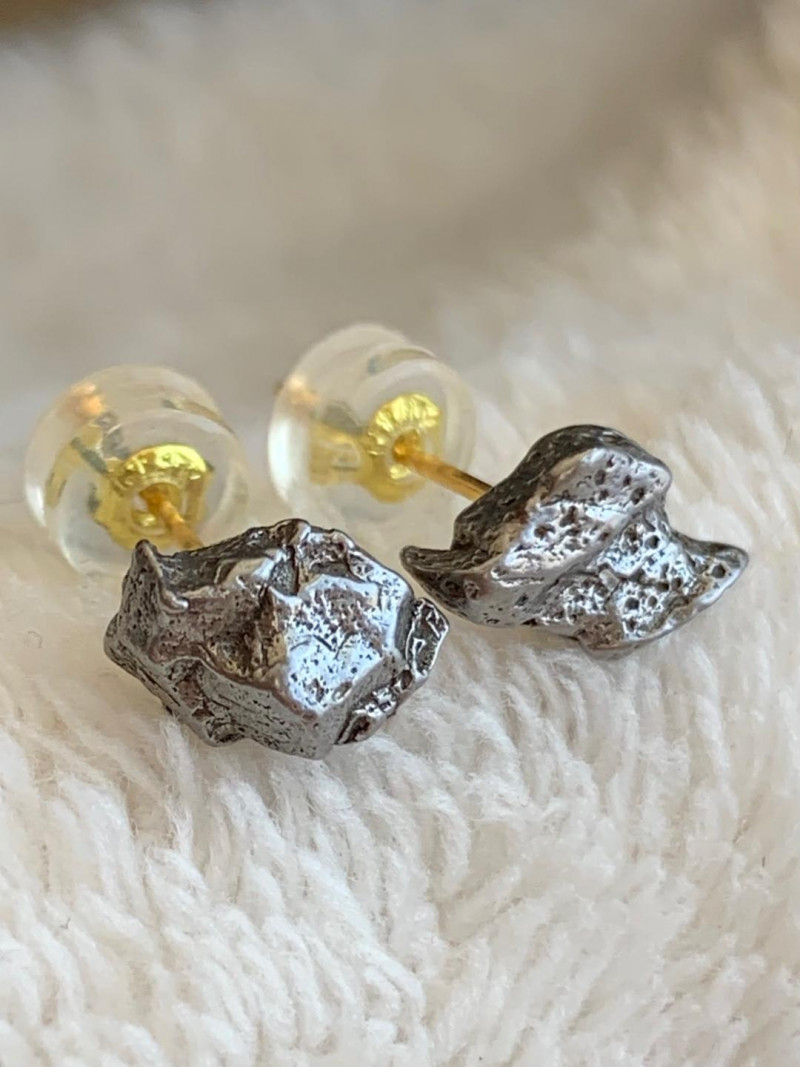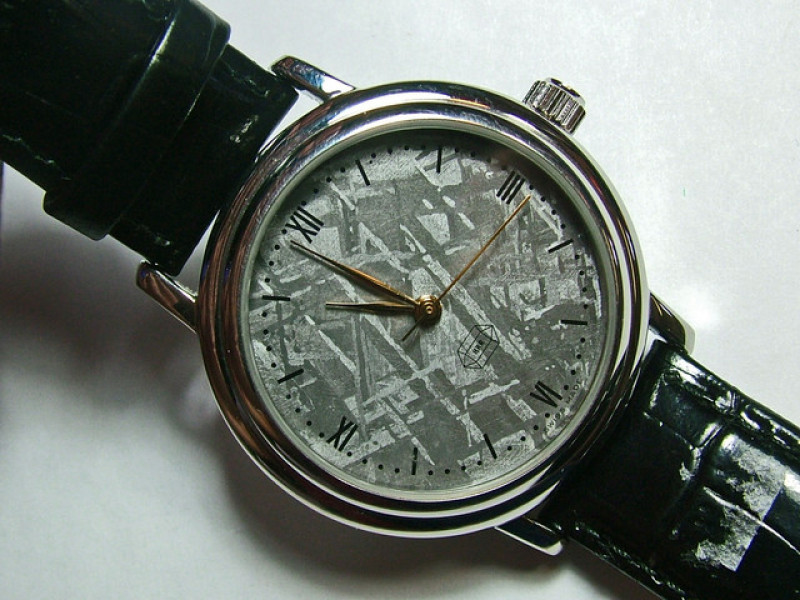
隕石の宝石:特性、意味、価値など
 隕石とは、宝石や装飾品として使用される宇宙から飛来した岩石または金属片です。科学的な隕石の定義は、地球の大気圏に突入し、地表に落下した宇宙ゴミのことです。
隕石とは、宝石や装飾品として使用される宇宙から飛来した岩石または金属片です。科学的な隕石の定義は、地球の大気圏に突入し、地表に落下した宇宙ゴミのことです。
ほとんどの宝石は母なる地球から来ますが、中には遥か彼方からやって来たものもあります。宇宙から来た石といえば、隕石が挙げられますが、隕石には他の宝石が含まれていることも少なくありません。
でも、待ってください。隕石は宝石なのでしょうか?厳密に言うと、そうではありません。隕石は岩石または金属に分類されます。しかし、宝石商は隕石をジュエリーや装飾品に使用します。
星に乗り、あの世へ旅立ち、隕石の特性、用途、宝石などについて探ってみましょう。

隕石とは何ですか?
隕石は暗い茶色または黒色で、通常は表面が滑らかですが、へこんだものもあります。
隕石は誕生石ではありませんが、 8月の誕生石であるペリドットを含む隕石も存在します。ペリドットは地球上で自然に生成されますが、中には「宇宙ペリドット」や「地球外ペリドット」と呼ばれるペリドットの結晶を含む隕石も存在します。
占星術的に、隕石は銀河起源であるため、あらゆる星座の石となります。
星座の特定は簡単ですが、隕石の鑑定はどうでしょうか?注目すべき特徴を見ていきましょう。
隕石の特徴と識別
地球には毎年約6,100個の隕石が落下していますが、実際に発見されるのは年間約10個程度です。では、隕石を見つけたかどうかはどうすればわかるのでしょうか?
いくつかの質問から始めましょう:
見た目より重いですか?隕石は大きさの割に非常に重いんです。
磁石に引き寄せられますか?隕石は鉄分を多く含むため磁石に引き寄せられますが、「石質」隕石の場合は紐で磁石を吊るす必要があるかもしれません(これについては後ほど説明します)。
卵の殻のような薄片状の外皮がありますか?角を削って確認する必要があるかもしれませんが、隕石には金属片と明るい色の内側があります。
ガラス状ですか、それとも不透明ですか?ガラス状なら隕石ではありません。
モース硬度スケールでは、隕石は蛍石と同程度の4~6の硬度です。ところで、隕石とはどのような石なのでしょうか?隕石の90%以上は岩石です。
では、隕石は何でできているのでしょうか?隕石は多種多様ですが、必ず3つのカテゴリーのいずれかに分類されます。
隕石の種類
地球上で発見された隕石の数はいくつだと思いますか?答えは6万個以上!では、隕石にはどんな種類があるのでしょうか?最も一般的なものから最も一般的でないものの順に見ていきましょう。
石質隕石
 (画像クレジット: Gabisfunny - 自身の作品、パブリックドメイン、 https://commons.wikimedia.org/w/index.php? curid=3351601)
(画像クレジット: Gabisfunny - 自身の作品、パブリックドメイン、 https://commons.wikimedia.org/w/index.php? curid=3351601)
石質隕石は主にシリカまたはシリカ鉱物ですが、ニッケルや鉄も含まれています。NASAによると、隕石の約94%は石質です。
石質岩石には、コンドライトとエイコンドライトという2つのサブカテゴリがあります。主な違いは、コンドライトにはコンドリュール(小さな岩石の球)が含まれていることです。
鉄隕石
 隕石の約5%は鉄隕石です。これらはほぼ完全に金属でできており、主に鉄で、ニッケルと微量の鉛やクロムなどの重金属が含まれています。
隕石の約5%は鉄隕石です。これらはほぼ完全に金属でできており、主に鉄で、ニッケルと微量の鉛やクロムなどの重金属が含まれています。
石鉄隕石

最後に、隕石の約1%は石鉄隕石です。その組成は金属とシリカがほぼ50/50です。
石鉄にはメソシデライトとパラサイトの2つの亜種があります。どちらも希少で、パラサイトは約45個、メソシデライトは約50個しか知られていません。
メソシデライトは、岩石の破片とマグネシウムを豊富に含むケイ酸塩宝石からなる角礫岩です。鉄ニッケル含有量は17~90%で、金属片や薄片が暗い背景と見事なコントラストを生み出します。
パラサイトは、内部に黄緑色のオリビンを含む光沢のあるニッケル鉄を含んでいます。
隕石に結晶があるのでしょうか? オリビンが透明で鮮やかな色をしているものは、 半貴石ペリドットです!
ペリドット結晶は宇宙から来た唯一の宝石ではありません。

隕石結晶の種類
隕石に宝石は含まれているのだろうかと疑問に思ったことはありませんか? 場合によっては、含まれていることもあります。
宝石質の隕石結晶を見つけるのは非常に稀です。主な理由は、高温と墜落によって内部の宝石が破壊されてしまうことが多いためです。もしファセット加工可能な宝石がまだ残っているとしても、それは百万分の一の確率です!
緑色の隕石結晶ペリドットに加え、火星産のオパールも隕石を介して地球に運ばれてきました。さらに、カーボナドダイヤモンドは宇宙での爆発によって形成され、その後小惑星や隕石に付着して地球に運ばれ、中生代初期のパンゲアに散らばったと考える研究者もいます。
いくつかの宝石は隕石の衝突によって形成されます。テクタイトは、隕石の鉱物と地球の鉱物が衝突地点で溶け合うことで形成される、独特の黒い隕石結晶です。
濃い緑色の宝石モルダバイトはテクタイトの一種です。約5万年前に隕石によって地球にもたらされたもう一つの宝石はモアッサナイトです。
隕石には美しい宝石が含まれているだけでなく、隕石自体も美しい宝石になります!隕石のその他の特性については、以下をご覧ください。
宇宙の驚異を公開:NWA 7401 隕石!
驚くべき天体のひねりとして、地球はこれまで見たことのない地球外からの来訪者、エンスタタイトコンドライトのELメルト岩石、NWA 7401に迎えられました。これはただの宇宙の岩石ではなく、地球へ旅立つ隕石のわずか2%を占める、特別な存在です。
地質学と隕石学の膨大な知識と照らし合わせながら、刺激的な科学的分析の探究を通して、私たちはその正体を解明しました。NWA 7401は単なる宇宙飛行士ではありません。一般的なコンドライトとは一線を画す、高貴なエンスタタイトコンドライトの一員なのです。
その組成を深く掘り下げれば、宇宙のスペクタクルが目の前に広がります! 斜方輝石と二次斜長石が主体で、粒子の大きさは最大100ミクロン。この隕石は、宇宙の驚異を凝縮した縮図です。時空を凍らせた、コンドリュールや細長い放射状の輝石結晶など、宇宙の様々な物語が詰まったアーカイブです。さらに、夜空の星のように、トロイライト、ドーブレライト、カマサイトの存在が、この隕石の個性をさらに際立たせています。
しかし、物語はそこで終わらない。この天体遺物の粒界は硫酸塩と酸化物で覆われ、容赦のない広大な宇宙を旅してきたその静かな証人となっている。

このスリリングな探究の旅の中で、謎に包まれたNWA 7401はその真の姿を現し、星々の中の宝石としてその地位を確立しました。それは単なる宇宙の断片ではなく、宇宙からの使者であり、地球の世界にはまだ知られていない広大な星々の秘密を囁く存在なのです。
隕石の仕様と特徴
色: グレー、ブラウン、ブラック、またはこれらの組み合わせ。内側は明るい色で、クロムのような輝きを放つ場合があります。
結晶構造:八面体晶(ウィドマンシュテッテン結晶構造の一部)または六面体晶 - どちらも鉄隕石にのみ存在する
光沢: 鈍い、金属的、または金属光沢未満
透明度:不透明
密度:8.00
胸の谷間:なし
破砕性:鋼鉄状(鉄隕石のみ)
縞模様:茶色、茶色がかったオレンジ色、またはなし
発光:オレンジ、緑、黄白色の燐光、黄色、赤、青の蛍光
ふぅ、科学的な話が多かったですね。もっとスピリチュアルな側面で言うと、隕石は何を表しているのでしょうか?

隕石の宝石の意味
隕石結晶の名前の意味を見てみましょう。
「隕石」という言葉は、ギリシャ語の「 meteōros 」(空高く)または「 meteoron 」(空の現象)に由来しています。とても分かりやすいですよね?
多くの古代社会では隕石は神聖なものと信じられており、隕石は天からやってきて超自然的な力を持っていると主張されることが多かった。
磁石の仕組みが知られる以前は、それは超自然的なものと考えられていました。そのため、隕石の磁気特性は、天界との関連性を強めるだけだったのです。
モルダバイトは隕石に混じって運ばれてきたわけではありませんが、最も強力な隕石とみなされることがよくあります。歴史的には幸運のお守りとして用いられ、聖杯に使われていたという噂さえあります。
モルダバイトはおよそ 5000 万年前に地球上で形成され、古代および現代のクリスタル ヒーラーは、人類の精神を変容させるために送られたと信じています。
そういえば、隕石は何の役に立つのでしょうか?

隕石の治癒力
すべての宝石は、その色と内部のエネルギーの性質により、癒しの石として機能します。
新しい隕石は通常黒色で、他の黒い宝石と同様に、地に足をつけ、豊穣をもたらし、守護する治癒特性を持っています。
古い隕石は通常、赤褐色になります。茶色の隕石の利点は、他の茶色の宝石と同様に、安定性、強度、そして心地よさを兼ね備えています。
隕石の結晶には、身体的、感情的、チャクラの治癒効果がありますか?
身体の治癒
肉体面では、クリスタルヒーラーは鉄隕石を血液の浄化、活力の増強、そして身体のバランスの改善に利用します。古代文化では、これらの石は生殖能力の向上にも効果があると信じられていました。
感情的な癒し
隕石は、自発性と精神的な気づきをサポートすると言われています。幸運な出会いをもたらし、生涯の友やパートナーをもたらしてくれるという人もいます。
チャクラヒーリング
チャクラヒーリングとは、背骨に沿って7つのエネルギーセンターがあり、感情や身体の症状と結びついているチャクラを開くことを意味します。宝石はチャクラストーンとして機能し、エネルギーを調整したり、詰まったチャクラを浄化したりします。
メテオライトは複数のチャクラに作用する石ですが、特に第三の目チャクラに効果的です。片頭痛、注意力散漫、目的を見失うことなどは、第三の目がブロックされている症状です。メテオライトを使用することで、第三の目チャクラが開き、精神的な繋がりや直感力を感じることができるでしょう。
隕石を身につけるのは、チャクラヒーリングの一つの方法です!もちろん、まずは購入する必要がありますので、購入時に注意すべき点を見ていきましょう。

隕石の宝石特性
他の宝石とは異なり、隕石は希少な産地と原産地が最大のセールスポイントです。しかし、カット、透明度、色といった宝石特有の特性も価値に影響を与える可能性があります。
カット:隕石はファセットカットと非ファセットカットの両方に対応できるほど耐久性があります。ファセットカットではない隕石の一般的なカットには、 カボション、ビーズ、スライスなどがあります。
色:隕石の内包物によって、様々な色や模様が生まれます。コンドリュールについては既にご存知かと思いますが、カルシウムやアルミニウムの内包物は、暗い鉄の層と明暗のコントラストを生み出します。
それを念頭に置いて、隕石はどのような恒星のアクセサリーに使用されているのでしょうか?
隕石ジュエリー
本物の隕石ジュエリーのほとんどには、石や金属の枠に加工された鉄隕石が含まれています。
隕石のサイズによって、ジュエリーの種類が決まります。例えば、小さめの隕石は隕石リングに最適で、大きめの隕石は人目を引くペンダントになります。
鉄隕石の中には、自然の模様を持つものがあり、宝石職人は石を酸処理することで、その模様を強調することがあります。隕石製の時計の文字盤やバンドは、この自然の模様を持つ隕石の断面から作られていることが多いです。
より希少な石鉄隕石はスライス状にカットされ、鉄に囲まれた緑と黄色の珪酸塩鉱物のカラフルな母岩が現れることもあります。これらのスライスは、まさに目を引く隕石ネックレスを作り出します!

隕石の歴史
隕石は地球を含む宇宙の歴史についての貴重な洞察をもたらしました。
科学的分析によれば、ほとんどの隕石は太陽系の歴史の初期に形成された可能性が高いが、隕石の年代は2億年から45億6000万年前までの範囲である。
紀元前3500年頃、古代社会では隕石を装飾品、道具、お守りなどに取り入れていました。エジプトの墓地から発見された隕石ビーズや、ツタンカーメン王の墓から発見された隕石の短剣などがその例です。
驚くべきことに、科学者たちは 1803 年まで隕石が宇宙から来たと信じていませんでした。
1700年代の「合理的思考者」の多くは、目撃情報を作り話と片付けていました。しかし、フランスの物理学者ジャン=バティズ・ビオが、レーグル隕石落下に関する報告書を発表したのです。ビオは、目撃証言と、岩石が地球由来ではないという科学的証拠を組み合わせ、隕石研究の礎を築きました。
最も最近の隕石の目撃は2021年10月3日で、バンクーバーの女性の家の天井を突き破ってベッドに落下し、彼女の頭をかすめた。
地球に落ちる前、あるいはカナダの寝室に落ちる前に、隕石はどのように形成されるのでしょうか?

隕石の起源と供給源
それぞれの種類の隕石は少しずつ形が異なりますが、大部分(石質隕石)は小惑星帯から来たもので、小惑星の破片が本来の軌道から外れて地球の軌道に落ちてきたものと考えられています。
鉄隕石は、破壊された惑星、準惑星、大型衛星、または小惑星の破片です。これらの惑星が破壊されると、その核は鉄隕石に分裂します。地球に落下した隕石は隕石に分類されます。「隕石」「流星体」「隕石」はすべて、宇宙を旅する過程の異なる段階にある同じ物体を指します。
石鉄隕石は、a) 太陽系が形成された際に余剰となった破片(くっついたもの)、または b) 月、惑星、または小惑星の地殻の破片から生成されます。
最終的に隕石が地球に到達すると、隕石は地球上のどこで見つかるのでしょうか?
採掘場所
隕石は世界中に無差別に落下しますが、砂漠は隕石が最もよく見つかる場所です。実際、南極大陸だけで、他のすべての大陸を合わせたよりも多くの隕石が発見されています。
南極は砂漠とみなされています(降雨量が少ないため)が、探検隊によってそこで約 42,000 個の隕石が回収されました。
隕石落下地点として知られているその他の有名な場所は次のとおりです。
アルゼンチン
チリ
中国
メキシコ
ナミビア
ロシア
アメリカ合衆国
隕石が見つかる確率は100万分の1ですが、隕石の価値はどれくらいでしょうか?

隕石の価格と価値
隕石の価値は希少性と独特の起源の組み合わせによって高くなることがありますが、必ずしもそうとは限りません。平均的な隕石の価格は、1グラムあたり0.5ドルから1,000ドルの範囲で、隕石の品質、産地、入手状況によって異なります。
隕石は密度が高いことを覚えておいてください。ゴルフボールほどの大きさの隕石は通常、その約4倍の重さになります。そのため、グラムあたりの価格は安くても、大きさと重量を考慮すると、すぐに高額になる可能性があります。
以下は卸売価格での隕石の平均価格表です。
鉄隕石:1カラットあたり約2ドル(1グラムあたり10ドル)
ケニア産パラサイトスライス:1カラットあたり10~25ドル(1グラムあたり50~125ドル)
オーストラリア産パラサイトスライス:1カラットあたり20~30ドル(1グラムあたり100~150ドル)

隕石のケアとメンテナンス
宇宙の未知の部分を考慮すると、隕石を身に着けるのは安全なのでしょうか?
はい、隕石は安全に身に着けられます。しかし、隕石の安全性に対する脅威は、人間の方がはるかに大きいのです!汚染や傷つきやすさなど、隕石は非常に壊れやすいものです。宝石職人は、損傷を防ぐために厳格な手順を踏まなければなりません。
販売されている隕石が適切に処理されている場合、価格は高くなる可能性があります。しかし、その価格は、石がはるかに長持ちすることに対する代償です。
隕石を準備する手順としては、湿気のない展示ケースに保管すること、清潔な綿の手袋で取り扱うこと、適切な方法で定期的に洗浄することなどがあります。
石質隕石を洗浄するには、歯ブラシを使用して汚れやほこりを拭き取り、純粋なアルコール(少なくとも 95%)に浸した清潔な布で石を徹底的に拭き、自然乾燥させます。
鉄隕石または石鉄隕石、特に錆びた部分をきれいにする方法は次のとおりです。
綿棒をカルシウム、石灰、錆除去剤 (CLR) に浸します。
浸した綿棒を各錆びた部分に軽く押し当て、各部分から錆を丁寧に拭き取ります。
石を容器に入れてアルコール(95%以上)をかけ、石をすすぎます。アルコールを浸した布で拭くか、アルコールを浸した綿棒を使うかのいずれかの方法で行います。CLRを完全に除去するために、歯ブラシを使う必要があるかもしれません。
石を自然乾燥させます。
石をオートマチックトランスミッションオイルに一晩浸しておきます。
清潔な綿の手袋をはめて石を取り出し、清潔な布かペーパータオルで余分な油を取り除きます。
隕石を長持ちさせるには、酸や家庭用化学薬品との接触を避け、一定の温度で乾燥した空気中に保管してください。
販売されている完璧な隕石の結晶を見つける準備はできましたか?

銀河の宝石を探しに?
宇宙は何十年もの間、私たちの冒険心を捉えてきました。同様に、隕石は科学者とクリスタル愛好家の両方を魅了し、未知への探求を促してきました。隕石クリスタルを手にすれば、限界を超え、好奇心を追い求める勇気が湧いてくるでしょう。
小説家ジャック・ロンドンはこう言った。「私は眠くて永遠の惑星になるより、体のあらゆる原子が壮麗に輝く素晴らしい流星になりたい。」
Gemstone Encyclopedia検索
最新記事
レインボーラティスサンストーンは、様々な内包物によって3つのゴージャスな光学的効果を持つ長石の一種です。燃えるように鮮やかな色合いと格子模様が、コレクターにとって希少な宝石となっています。
12th Jan 2026
チューライトは、ゾイサイト鉱物ファミリーに属する、鮮やかなバラ色の色合いを示す希少なノルウェー産の宝石で、ジュエリーのセッティングやペンダントによく使用されます。
6th Jan 2026
記事のカテゴリ
How To's is where you will find helpful articles from gem Rock Auctions on how to cut gemstones, select gemstones and buy gemstones.
9記事数

